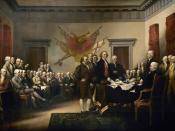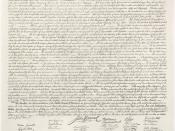Declaration of Independence, Articles of Confederation, and the Constitution
Unknown to many, there are numerous differences between the Declaration of Independence, Articles of Confederation, and the Constitution, besides their name. Although they go unnoticed, each shaped our country with great significance and grace. Each had its own purpose. Each had its own time.
The Continental Congress approved the Declaration of Independence on July 4, 1776 as a statement of the principles that, two days earlier, had led Congress to vote for the independence of the American colonies from Great Britain. It was designed to influence public opinion, both at home and abroad, especially in France, to which the United States looked for military support. The drafting of the document was entrusted to a committee consisting of John Adams, Benjamin Franklin, Thomas Jefferson, Roger Sherman, and Robert R. Livingston. Because of Jefferson's reputation as a literary craftsman, the committee assigned the task to him.
Two passages in Jefferson's draft were rejected by the Congress-an immoderate reference to the English people and a scornful criticism of the slave trade. The document was otherwise adopted without significant change, and formal signing by fifty-six members of Congress began on August 2, 1776.
The Articles of Confederation, drafted by the Continental Congress in 1777 and ratified in 1781, became the first constitution of the United States. The original draft, prepared by John Dickinson in 1776, contained provisions for a strong and possibly
viable national government, but state jealousies and widespread distrust of central authority led to the override of that document.
Citizens of each state were given equal privileges and immunities, freedom of movement was guaranteed, and procedures for the extradition of accused criminals were outlined. The articles established a national legislature called the Congress, consisting of two to seven delegates from each state;...


